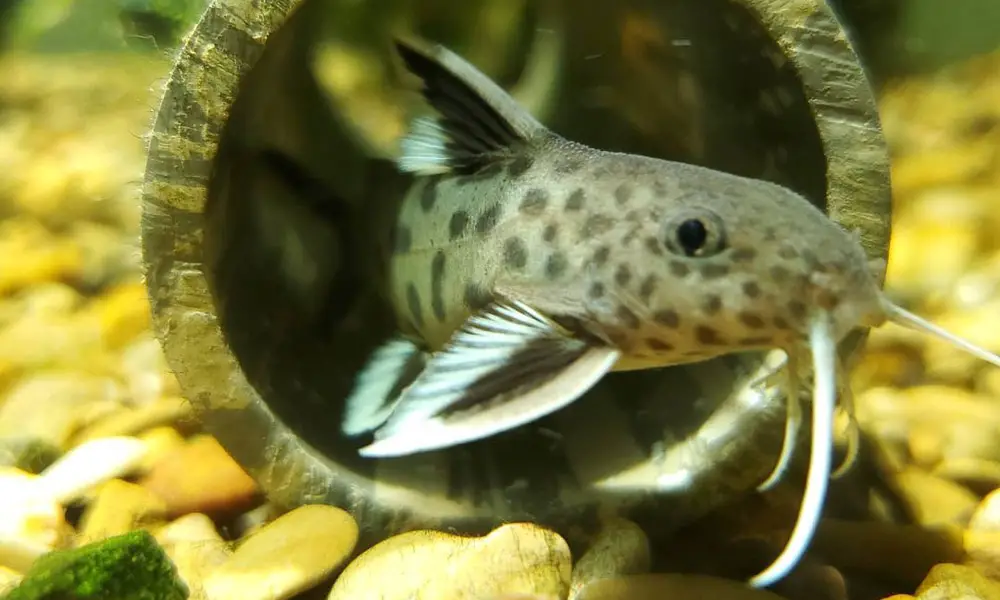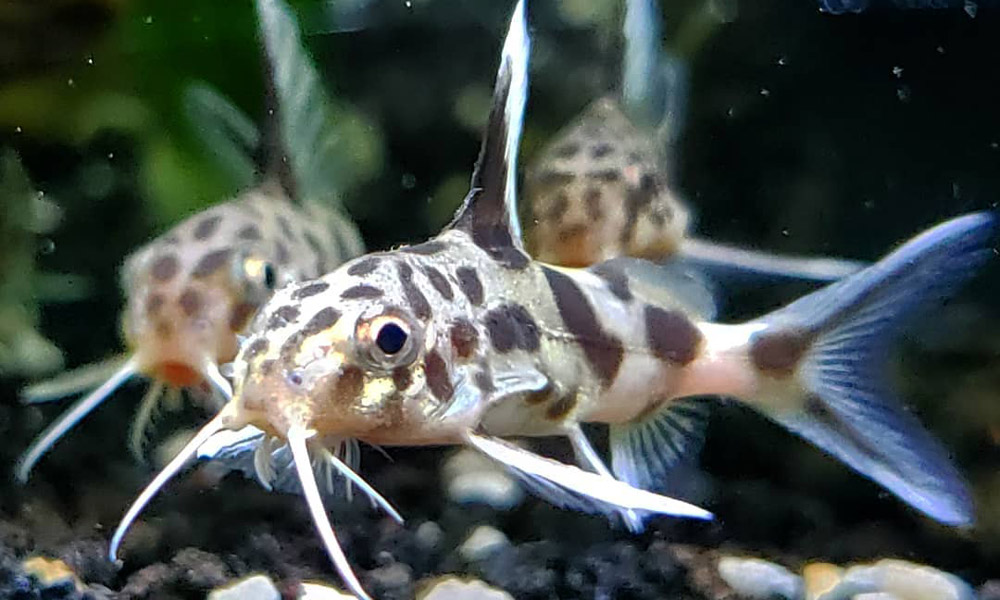Are you searching for a catfish for your African cichlids’ community aquarium? Synodontis multipunctatus, or cuckoo catfish, is a great choice! This peaceful bottom dweller is known for its distinctive spotted pattern and interesting upside-down swimming behavior.
But if you want to keep this beauty to cichlid aquariums, there are a few things you should know.
In this article, we’ll discuss the cuckoo catfish’s natural habitat, diet, and care. We’ll also give some tips on how to best keep this species in your aquarium.
By the time you’re done reading, you’ll be an informed owner who’s ready to provide the best care for your new cuckoo catfish!
Species Summary
The Cuckoo catfish (Synodontis multipunctatus), also known as the cuckoo squeaker, or multipunk, is a famous catfish endemic to Lake Tanganyika that is well-known for being the home of a number of cichlid species.
The cuckoo catfish gets its name from its unusual parasite reproduction behavior, which resembles those of a cuckoo bird. As you might know, a cuckoo can dart into an unattended nest of other birds, lay its egg, and be gone within 10 seconds.
In the wild, these fish swim in large schools at depths of about 40 m (130 ft) in the benthic zones of the lake. They are also a primary component of local commercial fisheries.
The cuckoo catfish belongs to the family of Mochokidae, which is known as the upside-down catfish and squeakers, but not all members swim upside-down.
Its genus Synodontis currently has over 131 recognized species. Since they can make stridulatory sounds by rubbing their spines on the pectoral fin, Synodontis species are also known as squeakers.
| Scientific Name: | Synodontis multipunctatus |
| Common Name: | Cuckoo Catfish, Cuckoo squeaker |
| Care Level: | Beginner |
| Lifespan: | 15 – 20 years |
| Max Size: | 6 inches (15cm) |
| Temperature: | 75 to 82°F (24 to 28°C) |
| PH: | 7.8 to 8.8 |
| Water hardness: | 15 to 25 degrees |
| Diet: | Omnivores |
| Minimum Tank Size: | 55 gallons |
| Temperament: | Peaceful |
Appearance

The cuckoo catfish is primarily known for its leopard-like pattern, making them a desirable pet for more aquarists. The base color of these species is generally whitish-grey with a whitish belly with or without spots.
These species feature round, dark spots of varying size on the base color. These spots are pretty larger in juveniles. They have maxillary and Mandibula barbels.
Both males and females feature black triangles at the base of the Dorsal and Pectoral fins. They also have an Adipose fin with a white dorsal edge. Pectoral spines in Cuckoo Catfish are thin and light-striped.
Males tend to have a higher dorsal fin while females are more rounded. The most accurate method of sexing cuckoo catfish is looking at their genital papilla. Males have a longer and pointier genital papilla, while females have a shorter and rounder one. Be aware that this method is not suitable for juveniles, and you have to wait until they mature.
Synodontis Multipunctatus (Cuckoo Catfish) Size
The average size of a Cuckoo Catfish is roughly 6 inches (15cm) in the home aquarium but has been recorded up to 10 inches (27.5 cm) in nature.
When they are sold, they are mostly 2 inches long. Cuckoo Catfish are relatively slow-growing fish; it takes 3-5 years to grow their full potential size.
They require a spacious aquarium to thrive. Offer them an ideal tank space and maintain the proper parameters that help them attain the maximum length.
Lifespan
The cuckoo catfish has an expected lifespan of around 15 – 20 years in captivity with proper care and diet, but there have been plenty of specimens that have exceeded this range, up to 27 years. What a longevity for an aquarium fish!
Another factor that can influence the lifespan of cuckoo catfish is their genetics. Despite the fact that these fish can be bred in captivity easily when you obtain a compatible pair, they’re widely used to produce man-made hybrids to create more exciting color patterns.
This can have a negative impact on the health of the cuckoo catfish and their lifespan as well. So, if you want your fish to live a long and happy life, make sure to get them from a reputable source.
Cuckoo Catfish Care

Cuckoo Catfish care is something that both beginning and experienced aquarists should have no trouble with. These species are peaceful and show their aggression fewer times, thus making them suitable for aquarists of all skill levels.
Compared with other Synodontis, S. multipunctatus remains a lot more active in the daytime as much as the night.
Being a gregarious species, the cuckoo catfish should be kept in small groups of at least 4 to 6 individuals for their continued well-being.
Offer them ample swimming space and plenty of hideouts, maintain the ideal water conditions, and let them grow in their new habitat.
Here’re some of the essential cuckoo catfish care guidelines that you should be mindful of.
Tank Size
The minimum tank size to keep a small group of 4 – 6 cuckoo catfish is at least 55 gallons (48″ x 13″ x 21″), as this will give them enough space at the bottom and lets them establish their territories.
You can start smaller with juveniles and work your way up; a minimum of 20 gallons (30″ x 12″ x 12″) will be fine. If you want to keep a larger group of cuckoo catfish, increase the tank size as appropriate.
You might be interested in these vertical column fish tanks: Best Column Fish Tanks
Water Parameters
Like any other Lake Tanganyika cichlids, cuckoo catfish thrive in water conditions that mimic the environment of their natural habit, where the temperature is a bit warmer, and water chemistry tends to stay stable.
The water should be well-oxygenated with a minimum nitrate amount. Carry out the regular water changes of 10% to 15% a week. Only do more if the water parameters swing out of the ideal range. A quality test kit should be used to monitor the water conditions.
- Contains one (1) API FRESHWATER MASTER TEST KIT 800-Test Freshwater Aquarium Water Master Test Kit,...
- Helps monitor water quality and prevent invisible water problems that can be harmful to fish and cause...
- Accurately monitors 5 most vital water parameters levels in freshwater aquariums: pH, high range pH,...
- Designed for use in freshwater aquariums only
- Use for weekly monitoring and when water or fish problems appear
Avoid any sudden change in the water chemistry. These fish can’t deal with it well unless the new water chemistry is similar to their current conditions.
Stick to the following water parameters and let these species grow healthily.
- pH: 7.8 to 8.8
- Water Temperature: 75 to 82°F (24 to 28°C)
- Hardness: 15 to 25 degrees
- Ammonia: 0ppm
- Nitrite: 0ppm
- Nitrate: <20ppm
They also produce too much biological waste; a powerful filtration is required to keep the water chemistry in check. Do not forget to cover the heaters with heater guards to protect these fishes from burning.
Decor (Plant & Substrate)
The cuckoo catfish will appreciate a soft sandy substrate to prevent injury to their sensory barbels while looking for food. You can add some rocks and caves to create plenty of hiding places but make sure there are no sharp edges that might hurt your fish.
These fish feel more comfortable in aquariums with subdued lighting, bright lighting will make them stressed, and they will hide away a lot during the daylight hours.
Food
The Cuckoo Catfish is omnivorous. They feed on snails, crustaceans, insect larvae, and other zoobenthos in the wild.
In the aquarium, they are unfussy and will accept most foods, including pellets, flakes, live, and frozen foods.
To keep a good balance, a high-quality cichlid pellet or flake is your best bet. Stick with sinking pellets, as these fish spend most of their time foraging on the aquarium bottom.
You can supplement their diet with live or frozen foods like brine shrimp, daphnia, and bloodworms. Vegetable matter such as blanched peas, chopped cucumber, lettuce, and zucchini should also be offered regularly, and you can also add algae wafers to their diet occasionally.
Feed them 2 to 3 times a day. Only give them as much as they can consume in a few minutes.
Breeding
The most interesting thing about Synodontis Multipunctatus is their breeding behavior. As we mentioned in the Species Summary section, the cuckoo catfish well deserves its common name because they will use a pair of their tank mates- mostly mouthbrooding species of Rift Lake, as parents to incubate their eggs, just like what cuckoos do in the wild.
Cuckoo catfish will be introduced to their spawning when they are stimulated by the smell of spawning cichlids in the same tank. This brood parasite will eat or slip in the cichlid’s eggs and replace them with its fertilized eggs before the female cichlid collects.
The female cichlid will mistake these eggs as their own and take them into her mouth for incubation. Interestingly, the cuckoo catfish’s eggs will hatch first, and the fry will feed upon the Cichlid eggs.
The fry will grow quickly and be free-swimming in about a week. You can start feeding baby brine shrimp to help them grow even faster.
If you intend to breed cuckoo catfish, it’s best to keep them with mouthbrooding cichlids to increase the chance of spawning. It’s quite rare to keep their own in a breeding tank for spawning.
Synodontis Multipunctatus (Cuckoo Catfish) Tank Mates
Synodontis Multipunctatus are gregarious species and are not overly aggressive. Keeping them in groups of at least four fish to avoid competition is always recommended.
However, they can be very aggressive and territorial towards other species within the genus Synodontis as well as other bottom feeders.
Cuckoo catfish are a great addition to African cichlid aquariums, which have been successfully housed with many cichlids of similar size from Lake Malawi, Lake Victoria, and Lake Tanganyika in the hobby.
Remember that cuckoo catfish fry will devour cichlids’ eggs, so if you have a breeding pair of cichlids in the community aquarium, it’s best to remove them to a separate tank.
Some of the Synodontis species that make good tank mates are:
- Blue Dolphin Cichlid (Cyrtocara moorii)
- Taiwan Reef Cichlid (Protomelas sp. Steveni Taiwan)
- Marlieri Cichlid (Julidochromis Marlieri)
- Lemon Cichlid (Neolamprologus leleupi)
- Caudopunctatus Cichlid (Neolamprologus Caudopunctatus)
- Synodontis Lucipinnis (Dwarf Petricola)
- Ctenochromis horei
- Tropheus moorii (Blunthead Cichlid)
Closing Thoughts
That’s everything you need to know about Synodontis Multipunctatus (Cuckoo Catfish) care. These fish are not only beautiful but also fascinating with their breeding behavior.
Give them optimal care, and they will stay with you for a long while. All you have to do is provide the right water environment and ideal tank mates.
If you have any suggestions on ways we can improve this care guide, or if you have any questions, please feel free to leave us a comment below!






